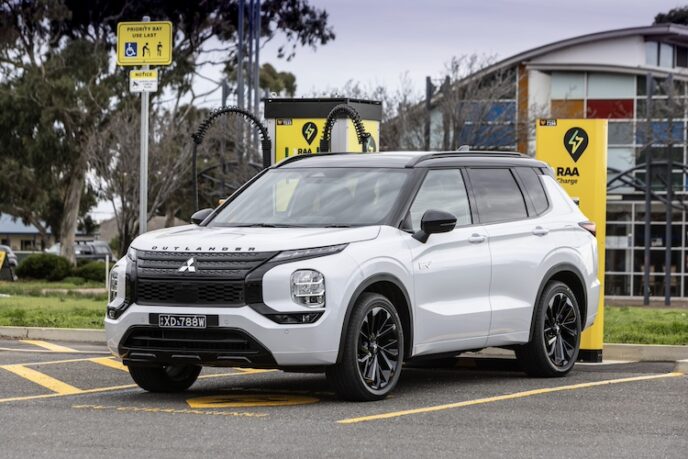
Mitsubishi Motors Australia Limited (MMAL) recently engaged research provider Platform One to survey more than 800 owners of the Outlander and Eclipse Cross plug-in hybrid electric vehicles (PHEV).
The Platform One data revealed that Outlander PHEV owners use their vehicles in EV mode 81% of the time, while Eclipse Cross PHEV owners use EV mode 75% of the time.
These figures contrast European data*, stating an EV share of only 45-49% for private PHEV owners.
The 2022 Mitsubishi Outlander Plug-In Hybrid EV offers up to 84km of electric range (according to ADR 81/02 testing) and a combined real-world range exceeding 800km.
The Outlander PHEV has supported the model’s top ten Australian vehicle sales position. Today, PHEVs make up 20 % of total Outlander sales (JATO, August 2024 YTD), compared to the previous generation’s total of under 5%.
The Eclipse Cross PHEV has also supported overall Mitsubishi PHEV sales, contributing 27% of all Eclipse Cross sales this year (JATO, August 2024 YTD).
Combined, Mitsubishi has 43% of the Australian PHEV new car market (VFACTS, August 2024 YTD). Most Mitsubishi PHEV owners charge daily (50% Outlander, 58% Eclipse Cross) and use home charging (97% and 96%, respectively).
The data revealed that 85% of Outlander PHEV owners and 89% of Eclipse Cross owners that charge at home use the domestic socket.
Transition technology
Owner verbatims revealed that PHEV owners had considered a BEV. However, price and infrastructure considerations tipped the balance towards PHEV. With many looking at a BEV in future, the PHEV option was seen as the right choice for today.
Since 2021, the electrified technology adoption curve has evolved from ‘early adopter’ to ‘early majority’.
Early adopters are seen as more willing to make the behavioural change needed to adopt BEVs, exploring the technology’s benefits and limitations that come with ownership.
The early majority is more pragmatic; they accept the need for change but are less willing to compromise behaviour if it negatively impacts their driving needs or lifestyle.
Verbatims:
- “Hybrid was the way to go at this stage. Maybe all-electric or hydrogen next time.”
- “Interested in moving away from ICE, but purchase price and range of EVs is very limiting.”
- “I am not convinced the public infrastructure is ready… hybrid is a stepping stone. My next car will be fully electric.”
- “As we travel in the country, we found a purely electric vehicle was not practical within our price range.”
- “I am transitioning to electric and have batteries at home and work. (PHEV) is the stepping stone.”
Real-world running cost reduction
When asked their top five reasons for choosing an Outlander PHEV, running costs was the number one response, with 45% of owners sighting this. ‘Fit for purpose’ and ‘Warranty length and inclusions’ ranked second and third, 41% and 38% respectively.
The Eclipse Cross PHEV owners rated running costs as the primary purchase reason, with 45%. This was also supported by ‘Warranty length and inclusions’, ranked second with ‘Fit for purpose’ third at 41% and 34%, respectively.
The data shows Mitsubishi PHEV owners see substantial real-world benefits, combining lower ongoing running costs with the 10-year warranty and capped price servicing program.
Some 92% of Mitsubishi PHEV owners agree that running costs are lower when charging the battery, with 92% agreeing that using EV mode improves real-world fuel economy while reducing the need to visit fuel stations.
Outlander PHEV insights (Eclipse Cross PHEV users in brackets)
- 62% of Outlander PHEV owners were new to Mitsubishi (64%), with the technology driving strong conquest sales.
- Two out of three PHEV owners intend to keep their vehicle for five years or more.
- 58% used adjustable regenerative braking via the steering wheel paddles (63%), further supporting battery state-of-charge and demonstrating PHEV owners are increasingly educated on how to maximise system efficiency.
- 45% used charge mode to top up the battery ‘on the go’ (39%), seamlessly reverting to EV mode as required.
*(Source: ‘Real-world usage of Plug-In Hybrid vehicles in Europe, 2022, International Council on Clean Transportation.)








